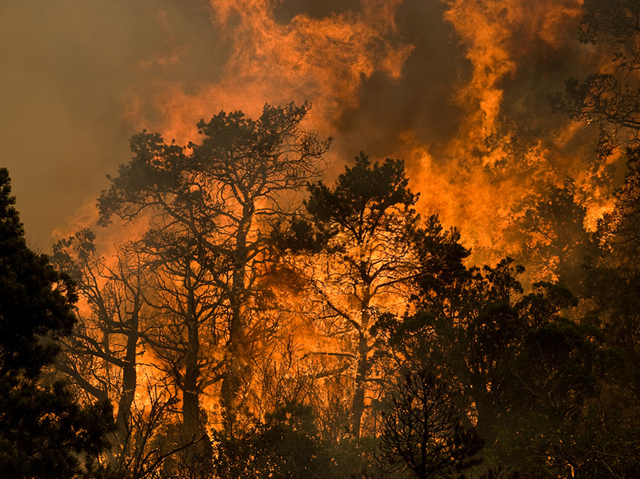As wildfires rage in U.S. West, scientists predict worse blazes to come – ‘Consistent disruption of current fire patterns for over half the planet’
By Nathanael Massey and ClimateWire
14 June 2012 When lightning struck Saturday in the foothills of the Colorado Rockies, 15 miles northwest of Fort Collins, conditions could hardly have been better for the wildfire that ensued. A dry winter and warm spring had left Roosevelt National Forest tinder dry, and strong, erratic winds whipping up from the southeast carried the flames easily through the pine trees. “The snowpack we had this year was below average — around 70 percent of average towards the end of February, followed by one of the driest, warmest Marches on record,” said Tim Mathews, a fire meteorologist with the Rocky Mountain Coordination Center. That trend continued through much of the spring, setting the stage for the current fire, he added. By yesterday, the blaze had affected some 46,600 acres of land, damaging 100 structures and resulting in at least one fatality, a 62-year old woman named Linda Steadman. Despite their severity, the High Park fire, as it has been named, and another, even more extensive fire in New Mexico are probably just the first blush of the year’s fire season. Officials are bracing for more such blazes, particularly in the western parts of Rockies, where, they say, conditions are even drier. “We got even less snow in the western corner of the state,” Mathews said. “We’re expecting more of this in the timber country.” Although no single fire, no matter how severe, can be concretely linked to global climate change, the climatic conditions seen in Colorado this year fit the kind of pattern scientists expect to see in the future. In one of the most comprehensive fire-modeling studies to date, researchers from the University of California, Berkeley, and Texas Tech University aggregated 16 separate climate models to map future fire-prone regions of the globe. Their findings suggest that, in the decades to come, fire prevalence will decrease in tropical regions — but will increase, possibly severely, at more northerly latitudes, and particularly in the western United States. “In next 30 years, we’re looking at pretty consistent disruption of current fire patterns for over half the planet — most of which involve increases” in severity, said lead author Max Moritz, a fire specialist based at UC Berkeley’s College of Natural Resources. Toward the end of the century, he said, an increased prevalence of fire becomes a near certainty for most of the Northern Hemisphere. […] The researchers realized they could apply the same science to fire. “Basically, we looked at fire as an organism,” said Moritz. “We asked ourselves, ‘What are its habitat requirements? What are the conditions under which fire’s going to thrive?'” […]
As Wildfires Rage in U.S. West, Scientists Predict Worse Blazes in Future

Thanks for this post.
Just tonight I was watching network TV and the forgot to mention that..